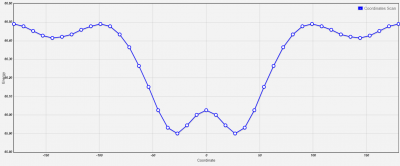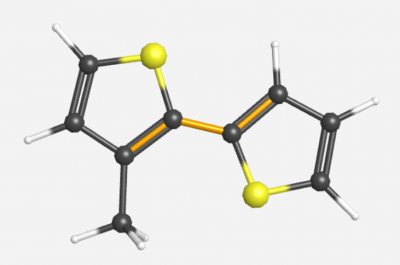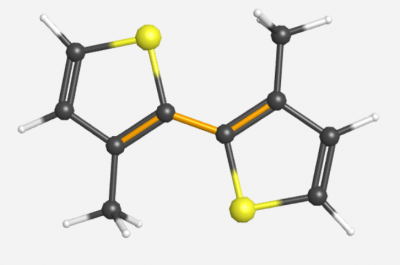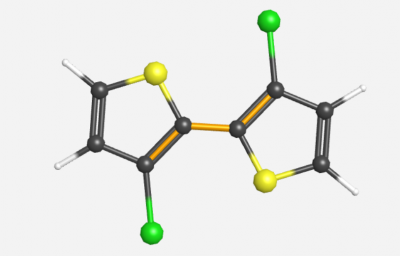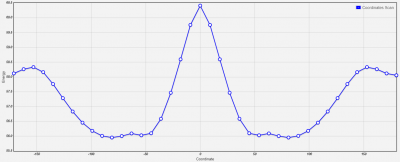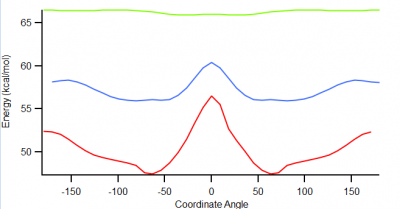Difference between revisions of "Rotational Energy Barrier Analysis of the Middle C-C Bond in P3HT Like Compounds"
| (7 intermediate revisions by the same user not shown) | |||
| Line 1: | Line 1: | ||
| + | ==Introduction== | ||
| + | P3HT stands for Poly(3- hexylthiophene- 2,5- diyl). This molecule has applications in materials chemistry. This experiment aims to analyze how changes in the substituents present in a dimer of P3HT affect the energy barrier of free rotation around the middle C-C bond to assess why this compound is utilized in material chemistry. | ||
==Materials and Methods== | ==Materials and Methods== | ||
| − | Obviously, I started off with building my molecules in WebMO, and to analyze the energy barriers associated with rotation around the middle C-C bond, I just edited to z-matrix and only scanned the middle C-C dihedral angle (180<sup>o</sup>), using 40 configure scans in all to generate a sufficient energy barrier graph. | + | Obviously, I started off with building my molecules in WebMO, and to analyze the energy barriers associated with rotation around the middle C-C bond, I just edited to z-matrix and only scanned the middle C-C dihedral angle (180<sup>o</sup>), using 40 configure scans, from -180.0<sup>o</sup> to 180.0<sup>o</sup>, in all to generate a sufficient energy barrier graph. |
| − | A semi-empirical approach with Parametric Method 3 (PM3) was utilized for each compound. I tried working these calculations with an ab initio approach using Hartree Fock (HF); however, this method was unable to generate | + | A semi-empirical approach with Parametric Method 3 (PM3) was utilized for each compound. I tried working these calculations with an ab initio approach using Hartree Fock (HF); however, this method was unable to generate energy barriers for any of the 40 coordinates that were scanned. |
Below is a picture of the general format I used to configure these jobs in WebMO. | Below is a picture of the general format I used to configure these jobs in WebMO. | ||
| Line 36: | Line 38: | ||
[[File:Screenshot 2021-04-08 202258.png|400px]] [[File:Screenshot 2021-04-08 202735.png|400px]] | [[File:Screenshot 2021-04-08 202258.png|400px]] [[File:Screenshot 2021-04-08 202735.png|400px]] | ||
| − | ==Overall Rotational Energy Barrier Comparison between the Unsubstituted P3HT, | + | ==Overall Rotational Energy Barrier Comparison between the Unsubstituted P3HT, P3HT with 2 Methyl Substituents, and with 2 Chlorides== |
[[File:Screenshot 2021-04-15 153321.png|400px]] | [[File:Screenshot 2021-04-15 153321.png|400px]] | ||
| + | |||
| + | green = unsubstituted P3HT | ||
| + | |||
| + | blue = P3HT with 2 chloride substituents | ||
| + | |||
| + | red = P3HT with 2 methyl substituents | ||
| + | |||
| + | Obviously an unsubstituted P3HT like compound would not have great applications in building a sturdy material, for the middle C-C bond is free to rotate around its axis pretty much unhindered. When we add 2 chloride substituents in, we have more strain, but still not a sufficient amount. Finally, when we analyze this dimer with 2 methyl substituents, a good amount of strain compared to the other 2 compounds is apparent. This leads to a solid prediction that the actual dimer of P3HT, with a longer hydrocarbon substituent, works well in materials chemistry due to the increasing strain on rotation with increasing sterics. | ||
Latest revision as of 21:33, 15 April 2021
Introduction
P3HT stands for Poly(3- hexylthiophene- 2,5- diyl). This molecule has applications in materials chemistry. This experiment aims to analyze how changes in the substituents present in a dimer of P3HT affect the energy barrier of free rotation around the middle C-C bond to assess why this compound is utilized in material chemistry.
Materials and Methods
Obviously, I started off with building my molecules in WebMO, and to analyze the energy barriers associated with rotation around the middle C-C bond, I just edited to z-matrix and only scanned the middle C-C dihedral angle (180o), using 40 configure scans, from -180.0o to 180.0o, in all to generate a sufficient energy barrier graph.
A semi-empirical approach with Parametric Method 3 (PM3) was utilized for each compound. I tried working these calculations with an ab initio approach using Hartree Fock (HF); however, this method was unable to generate energy barriers for any of the 40 coordinates that were scanned.
Below is a picture of the general format I used to configure these jobs in WebMO.
Middle Dihedral Angle with No Substituents
Symmetry: C2h
The molecule above was used for analysis. For the first molecule, the hydrocarbon substituents were removed.
This calculation took 40.6 seconds to complete.
Middle Dihedral Angle with One Methyl Substituent
Symmetry: C1
Middle Dihedral Angle with Two Methyl Substituents
Symmetry: C2h
Replacement of Methyl Substituents with Functional Groups
Overall Rotational Energy Barrier Comparison between the Unsubstituted P3HT, P3HT with 2 Methyl Substituents, and with 2 Chlorides
green = unsubstituted P3HT
blue = P3HT with 2 chloride substituents
red = P3HT with 2 methyl substituents
Obviously an unsubstituted P3HT like compound would not have great applications in building a sturdy material, for the middle C-C bond is free to rotate around its axis pretty much unhindered. When we add 2 chloride substituents in, we have more strain, but still not a sufficient amount. Finally, when we analyze this dimer with 2 methyl substituents, a good amount of strain compared to the other 2 compounds is apparent. This leads to a solid prediction that the actual dimer of P3HT, with a longer hydrocarbon substituent, works well in materials chemistry due to the increasing strain on rotation with increasing sterics.


